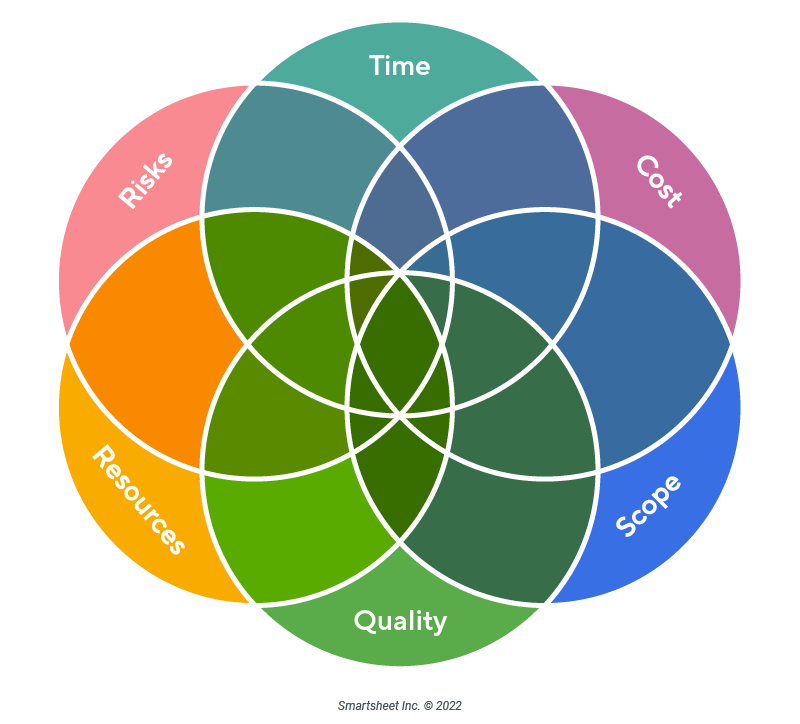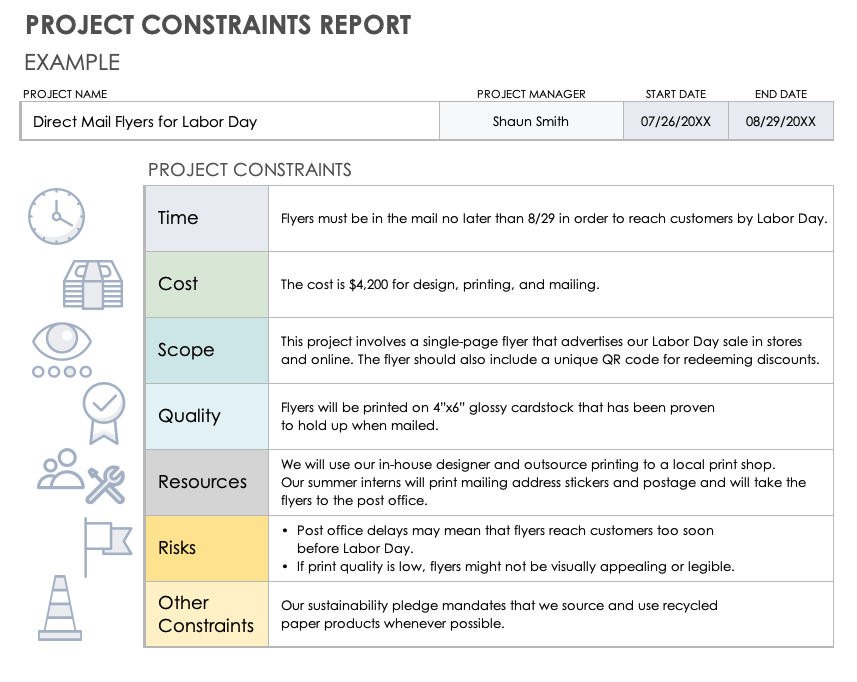What Are Project Constraints?
Project constraints are the limits within which a project must operate. The six main project constraints are time, cost, scope, quality, resources, and risks. Managers must balance these constraints in order to ensure successful project completion.
“Project management is the practice of delivering a solution subject to constraints. Constraints are things that limit or put boundaries around your projects. Scope, schedule, and cost are the big three, but risk, quality, resources, regulations, and other factors are also relevant,” explains Alan Zucker, Founder of Project Management Essentials, LLC.
The Theory of Constraints assumes that there is always at least one constraint present that prevents a company from moving forward. In most cases, that is time, cost, or scope, which together make up the triple constraint triangle. Sometimes called the iron triangle, these three are often considered to be the most pervasive constraints and are therefore the most important to account for.
Project managers initially outline constraints in their project charter and expand upon them in their project plan.
What Are the Six Constraints of a Project?
The six main project constraints are time, cost, scope, quality, risks, and resources. There might be additional constraints based on the size of your project or your industry. Most project managers focus only on managing these six.
This six-constraint model is useful for remembering that a single constraint can affect any or all other constraints, sometimes in ways you might not expect. It is important to remember that altering one element of a project might result in a need to balance one or more of these constraints. Think of this model as a six-circle Venn diagram where all circles overlap.
These are the six most common constraints in project management:
- Time: Time refers to individual task and project deadlines. Project managers usually manage time with such tools as calendars and scheduling software.
- Cost: Cost refers to the financial costs of your project, including labor, materials, equipment, and more. Project managers usually handle and represent cost in the project budget.
- Scope: Scope refers to all tasks that the project does and does not cover.
These first three constraints — time, cost, and scope — represent the triple constraint triangle and are closely related. A change in one will likely mean changes for the other two. - Quality: Quality refers to the level of quality required for satisfactory completion of a project. How you manage time, cost, and resources will directly impact quality.
- Resources: Resources refer to any resource you need to complete a project. These include those you have available and those you still need to acquire. Resources can cover time, people, equipment, facilities, software, or anything else your project requires.
- Risks: Risks refer to all possible circumstances that might affect your project, both positively or negatively. Risks can be either internal or external constraints depending on the source of the risk.
Internal Project Constraints
Most project constraints come from factors that are within an organization’s control. Internal constraints include time, cost, scope, quality, resources, certain risks, and more. Organizations can take many actions to manage these constraints.
We’ve outlined each of these internal constraints below:
- Cost: The financial capital your company has available to spend determines the budget for your projects.
- Organizational Decisions: An organization chooses the methods it will use to get the job done. There might be additional constraints based on the project management methodology chosen, the physical size of the office, the organizational layout of the company, hiring and staffing procedures, or internal training.
- Quality: Company leaders set both the desired level of quality and the methods for determining that quality.
- Resources: The resources available for use on your project are determined by the allocation and acquisition strategies of your organization.
- Risks: Internal project risks can refer to finances, organizational strategy, or performance. Proper risk management practices help keep these constraints in line.
- Scope: Project stakeholders and managers determine a project’s scope internally.
- Sustainability: An organization’s commitment to sustainability might be related to external factors such as legislation and public approval, but organizations manage the constraints surrounding it internally. Sustainability is closely related to both resource and organizational constraints.
- Time: Executives and project managers determine project schedules and deadlines internally.
External Project Constraints
Some project constraints exist outside the control of an organization and its employees. These constraints include social, economic, technological, legislative, environmental, and security factors. It is important to account for these external constraints when possible.
We’ve outlined some common external project constraints below:
- Economic: Economic constraints relate to the changing global or local economic environment as a whole. They can also refer to competitor strategies, recessions, upturns, or anything else having to do with the overall economic climate.
- Environmental: New legislation or shifting public opinion might create environmental constraints, which means they are closely related to social and legislative limits. They also refer to the environmental impact of your processes and products.
- Legislative: Legislative constraints are rules and regulations you must operate within to remain on the right side of the law. They can also include new certification or permit requirements based on new policies. Political shifts or new laws often lead to these types of constraints.
- Risk: External risks include major weather events, employee leave, market volatility, or changing legislation. External risk constraints are caused by external factors and can be difficult to manage because they are hard to predict. However, most project managers find that the benefits of managing project risks greatly outweigh the costs.
- Security: Security constraints refer to the need to protect sensitive data and materials. These are often closely aligned with technological constraints. They can also include building security or restricted access to equipment.
- Social: Social constraints include the likes of customer satisfaction and public opinions of your brand, policies, and products.
- Technological: Technology can refer to any equipment or software you use to get your work done. Changing technology can lead to new opportunities. It can also leave you constrained if you use outdated technology.
Internal and External Project Constraints Venn Diagram
Use this project constraints Venn diagram to quickly reference the various types of internal and external constraints you might encounter in your projects.
Project Constraints Examples
Project constraints are present in every project. This is true for projects of any size and in any industry. We asked experts to share examples of project constraints, including legislative, resource, time, and risk constraints.
Some real-life examples of project constraints from the experts include the following:
- Legislative Constraints: Legislative constraints can run the gamut from what you are allowed to produce to how you are allowed to produce it. Some industries have their own regulatory bodies that decide how companies can conduct business and threaten retaliation when they don’t comply. “Anything involving healthcare faces a slew of regulatory constraints, from HIPAA protections for patient information to regulations regarding care and treatment plans or even regulations regarding what healthcare employees can and cannot accept from vendors,” says Beran.
- Resource Constraints: Resource constraints are often closely related to costs. Your resources might be constrained if you are unable to purchase supplies at as high a quality as you have in the past because of price changes from the supplier, or you might not be able to hire additional highly specialized staff for a particular task. Resources can also include the equipment you use to produce your goods. For example, they can become constrained in this scenario if your equipment is aging or outdated and unable to keep up with production demands.
- Time Constraints: Sometimes balancing constraints means prioritizing them. “Time is often the most critical constraint. Sometimes it does not matter how good your product is if you can’t deploy it as scheduled,” explains Marcos Isaias, Project Manager at Claro RD. “Let's say we create a Mother’s Day offer for our product. It does not matter how much the scope and cost have to change if we are committed to launching the product before Mother’s Day. For this reason, if we have to increase costs or reduce scope to maintain the target launch date, it is acceptable because it is justified.”
- Risk Constraints: Managing risk constraints means asking yourself what is the acceptable level of risk for each project. This level will likely differ among projects, so it is important to consider risk constraints individually.
“A project manager must be able to predict possible failures at every stage of the project and plan for them appropriately,” says Hauer. “Playing out what-if scenarios and devising contingency plans are examples of this. What happens if a vendor fails to deliver? What if one or more resources are lost due to illness or transfer? What if the market swings dramatically? What if a competitor releases a product that is similar to ours at the same time?”
He continues, “When managing risks as a constraint, you must determine your organization's and stakeholders' risk tolerance zones, which entails identifying a reasonable range of reactions within appropriate bounds. If a supplier fails, for example, you will look for another within X pricing, Y delivery time, and Z quality parameters. Your stakeholders must select how much risk they are willing to bear in order to enjoy the project's proposed advantages by defining a zone of tolerance.”
Project Constraint Examples by Type and Industry
In this chart, you’ll find examples of each of the six main types of constraints in the construction, IT, and marketing industries.
| Construction | IT | Marketing | |
|---|---|---|---|
| Time | The team must complete construction on the building before the client opens their new store location. | The team must complete a new app before its debut at an upcoming conference. | Marketing materials must be in the mail to customers before Labor Day for a Labor Day sale. |
| Cost | The construction team must stay within an approved budget for materials and labor. | The budget includes money for research, development, and testing. | The budget includes research, design, printing, and mailing. |
| Scope | The building plans specify what the construction team needs to build and what will be built elsewhere. | The app is a supplement to an existing product, so it must integrate with and augment the experience of that product. | The campaign includes 400 flyers delivered by mail to addresses within one mile of the store one week before Labor Day. |
| Quality | Construction must meet standards of quality in order to pass inspection and fulfill the client’s expectations. | The app must perform without bugs on all platforms. | Flyers must be visually appealing and printed on high-quality glossy cardstock that can survive shipping. |
| Resources | This project requires building materials, construction software, vehicles, and labor. | This project requires one lead and three junior developers, a UX designer, all necessary software, and up-to-date hardware. | This project requires designers and writers, printers and ink, glossy cardstock, postage, and a list of local addresses. |
| Risks | Risks include failed inspections, schedule changes caused by shipping delays, and low availability of laborers. | Risks include schedule delays, hardware and memory failures, and difficulties formatting the app on multiple platforms. | Risks include mail delays and poor print quality. |
Project Constraints Report Example
Download Project Constraints Report Template with Example Data
Microsoft Word
| Google Docs
Use this project constraints report template to outline and share your project’s constraints. This customizable template includes space to detail the six main project constraints, as well as a section to share additional constraints. Use this template along with your project plan to help keep track of and manage your project constraints.
How to Identify Project Constraints
In order to identify project constraints, you have to identify boundaries in your project. These can be elements like your budget, timeline, or quality standards. Review these to find your project constraints.
“Foundational project documents, such as your project charter, will provide insight into some of the initial constraints. They describe what your customers want, roughly how much they are willing to spend, and how long they are willing to wait. While these documents may define the initial expectations, project managers should expand those boundaries once they learn more about the project,” says Zucker.
“Agreements, including contracts, internal service agreements, policies, regulations, and standards, are another source for identifying and understanding project constraints,” he continues. “Local regulations might stipulate construction or development standards. Contracts might define resource, cost, or quality constraints. Stakeholders, which include customers, the project team, senior leadership, or the general public, might also provide us with essential constraints. For example, a homeowners association might limit the color choices on your exterior trim.”
To aid in the creation and organization of these documents, you may consider using our template starter kit to identify and describe the constraints found in your project.
Project Constraints Template Starter Kit
Download Project Constraints Template Starter Kit
Use this starter kit to ease the process of working with project constraints. You’ll find everything you need to get started identifying and managing constraints in any project, including the project constraints report template found above. These templates are all fully customizable to suit the needs of your organization. Each template can be downloaded individually below, or as a set in the complete kit.
In this kit, you’ll find:
- A project charter template for Microsoft Excel to help you begin to organize your project thoughts and identify potential constraints.
- A project budget template for Microsoft Excel to identify and manage cost constraints.
- A project schedule template for Microsoft Excel to help map out time constraints.
- A scope statement template for Microsoft Word to help identify what is within the scope of your project, as well as what is not.
- A blank version of the project constraints report template for Microsoft Word found above on this page, to outline and share all of your project constraints with stakeholders.
For more help identifying and managing project constraints, check out our collections of project charter templates and project assumption templates.
How Do Project Constraints Affect Each Other?
When you change one project constraint, it will often impact the others. For instance, if a budget decreases, project managers will need to adjust the resources and timeline. Consider all constraints to ensure that projects are successful.
A good project manager knows how to stay within project constraints, but they also know when they can exceed them. The triple constraint triangle is one of the best examples. When scope increases, so must cost and time to balance it. In this scenario, if these constraints are not balanced, the project will cost more, take longer, and decrease in quality.
“On the market, there will always be some expectations. Managers should always be prepared to make accurate assessments at the start of a project. They should also be able to identify how and whether any adjustments made along the journey will affect the quality of the final product,” explains Max Hauer, Founder and CEO of Goflow.
When you exceed constraints, the project manager should determine the cause and decide whether or not the project should continue in its current form. Often, they will implement changes to avoid exceeding other constraints or exceeding any one constraint too much. This is why project managers should always build emergency funds into budgets and account for lead and lag time. By doing so, they can patch small holes before they become large ones.
“Balancing is admittedly tricky,” says Molly Beran, an experienced project manager and Founder of Projects By Molly, LLC. “In the past, I've done my due diligence to get as many constraints out in the open as possible and tried to figure out which ones work together and which ones compete. For example, you may have a budget constraint of not spending over a certain dollar amount, but you also have a time constraint of getting a project done in four weeks. If you have too much work and need more resources within those four weeks, it can be hard to meet both the budget and the time constraint.”
How Are Project Constraints and Dependencies Related?
Project constraints and dependencies both deal with project operations. Dependencies are the relationships between tasks that determine the order of work. Constraints are the boundaries in which the team must operate.
Project dependencies refer primarily to the order in which related tasks must be started and finished. Constraints refer to the limits of elements such as cost, time, and scope. Dependencies might also rely on certain constraints. For example, if you are constrained by having only one translator on a team, you must wait for them to finish translating an article before you can publish it. This will impact the time it takes to publish articles.
“Dependencies and constraints are both critical components of every project. Projects are fundamentally a collection of interconnected tasks with a priority order and connectivity to one another, resulting in project management dependencies,” Hauer explains. “Constraints, on the other hand, occur because a project has a set of requirements, a deadline for completion, and other features that limit how you can approach the project. You may also be constrained by the technology you have access to or a lack of devoted resources.”
How to Manage Project Constraints
In order to manage constraints, learn how to identify and understand them. Communicate with your team, maintain flexibility, and manage your resources well. We’ve asked experts for advice on how to manage project constraints.
These are some of the best practices for managing project constraints, according to experts:
- Be Flexible: When possible, be flexible. Adaptability can save you some headaches in the long run. “You can often make some trade-offs by considering alternatives. Usually, there are multiple options for achieving a project goal. If you consider your options, you may avoid forcing these hard choices,” says Zucker.
- Communicate: Encourage open communication within your team, and maintain open communication with project sponsors. Identify constraint issues early on in the process, and discuss them as soon as possible. “Having a constant flow of communication with the team regarding the constraints is vital. Having weekly sessions with the team and creating reports to circulate to all stakeholders will help you be in control of all project limitations and allow you to act on time if you see any constraint changes,” says Isaias.
- Create a Process for Approaching Constraints: Make identifying constraints a required part of the project initiation phase of project planning, and check their balance periodically. “To successfully manage project constraints, you need a process. The process should describe how you will identify constraints initially and on an ongoing basis. Constraints should be documented, reviewed, and analyzed periodically. Ask yourself, ‘Is this constraint still valid? Have we been honoring the constraint? Are there alternatives for addressing it?’” suggests Zucker.
- Create a Project Budget: Many cost constraint issues can be resolved by creating and maintaining an up-to-date project budget. Use one of our customizable project budget templates to construct a thorough budget for your next project.
- Create a Project Schedule: A well-considered schedule can help a team balance or avoid many time-based constraints. To learn how to create a comprehensive schedule of your own, check out this guide to project scheduling.
- Create a Risk Management Plan: Many constraints are related to potential project risks. One of the best ways to combat them is with a solid risk management plan. Browse this collection of risk management plan templates to create your own.
- Identify and Understand Constraints: The most important thing you can do is to learn how to identify the constraints and understand the ways that they affect one another. “When constraints compete, the best way to manage them is to identify the trade-offs of each constraint. Project managers can do this in a number of different ways: listing out the pros and cons of each, projecting out into the future with what-if scenarios, or simply spelling out what it would take to meet each constraint and what would be gained or lost by prioritizing one over another,” explains Beran.
- Manage Your Resources: Almost all constraints are resource based. Resources include such factors as time, money, labor, equipment, and more. Adopting solid resource management practices will help inform your constraint balancing practices.
- Stick to Your Project Plan: All successful project managers know the value of a good project plan. By outlining your early project assumptions and sticking to your initial plans, you are more likely to anticipate and manage conflicts between constraints.
- Use Software: Many project management software solutions include functionality to create schedules, track budgets, and manage risks, which all aid in managing project constraints.
Deliver Projects Effectively While Managing Constraints with Smartsheet
From simple task management and project planning to complex resource and portfolio management, Smartsheet helps you improve collaboration and increase work velocity -- empowering you to get more done.
The Smartsheet platform makes it easy to plan, capture, manage, and report on work from anywhere, helping your team be more effective and get more done. Report on key metrics and get real-time visibility into work as it happens with roll-up reports, dashboards, and automated workflows built to keep your team connected and informed.
When teams have clarity into the work getting done, there’s no telling how much more they can accomplish in the same amount of time. Try Smartsheet for free, today.





